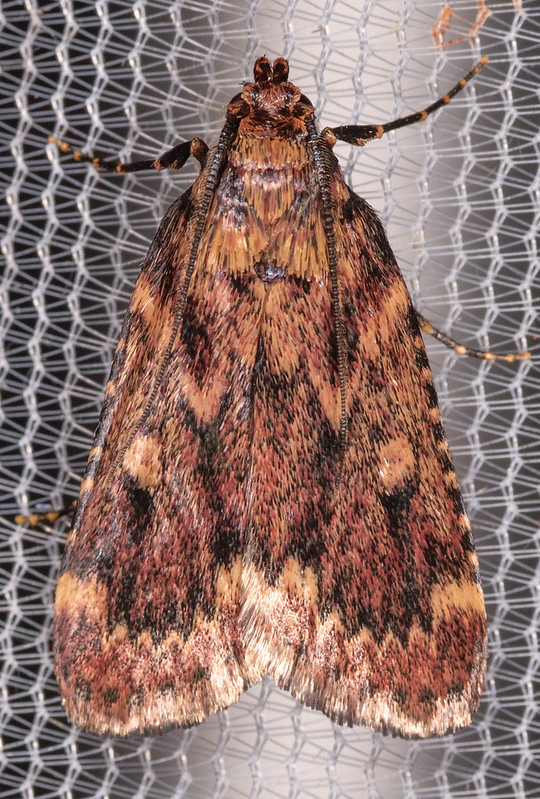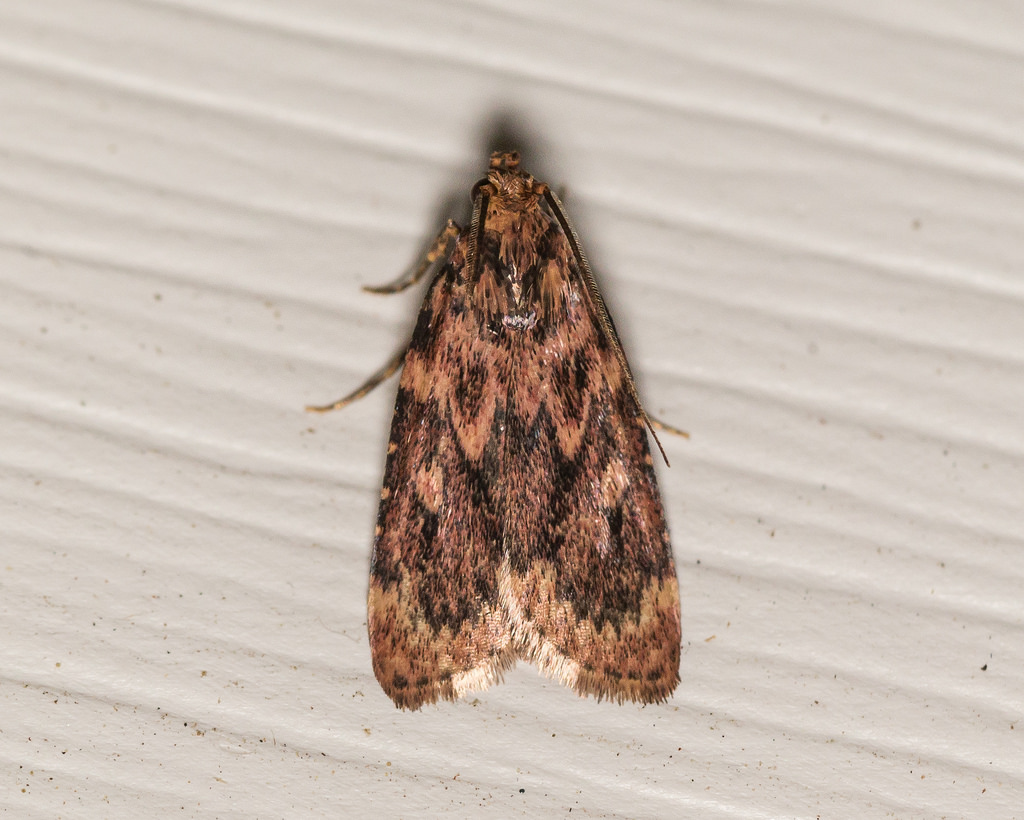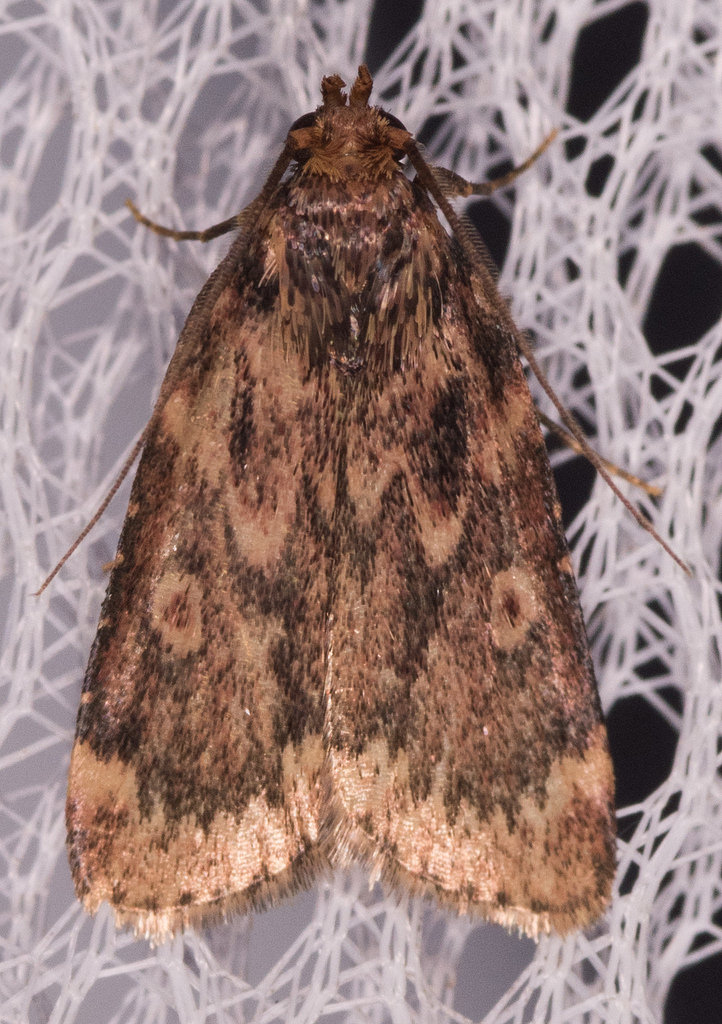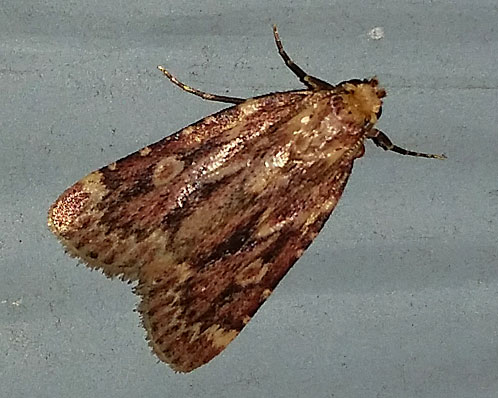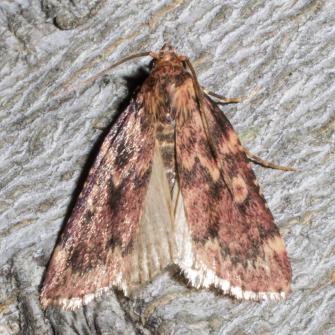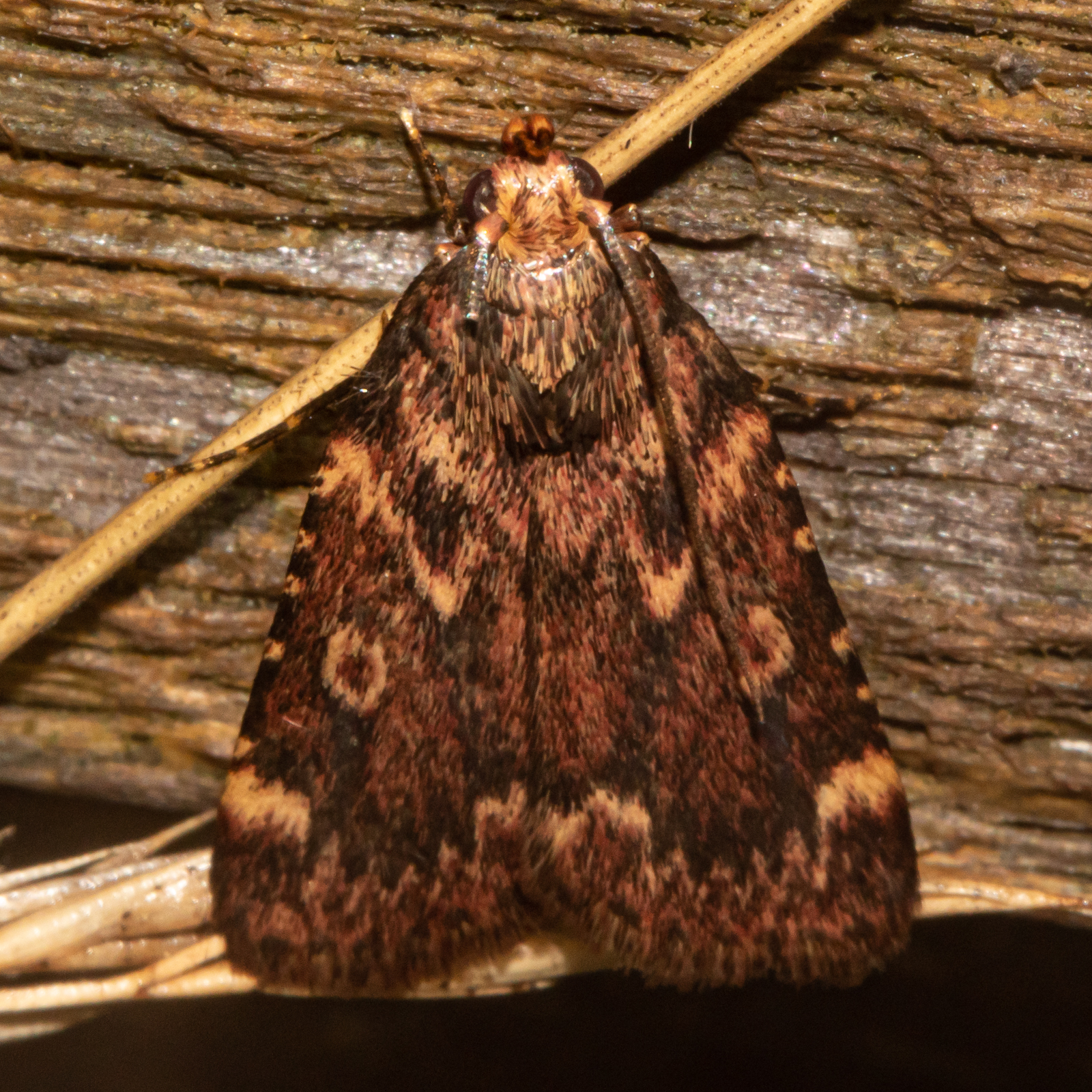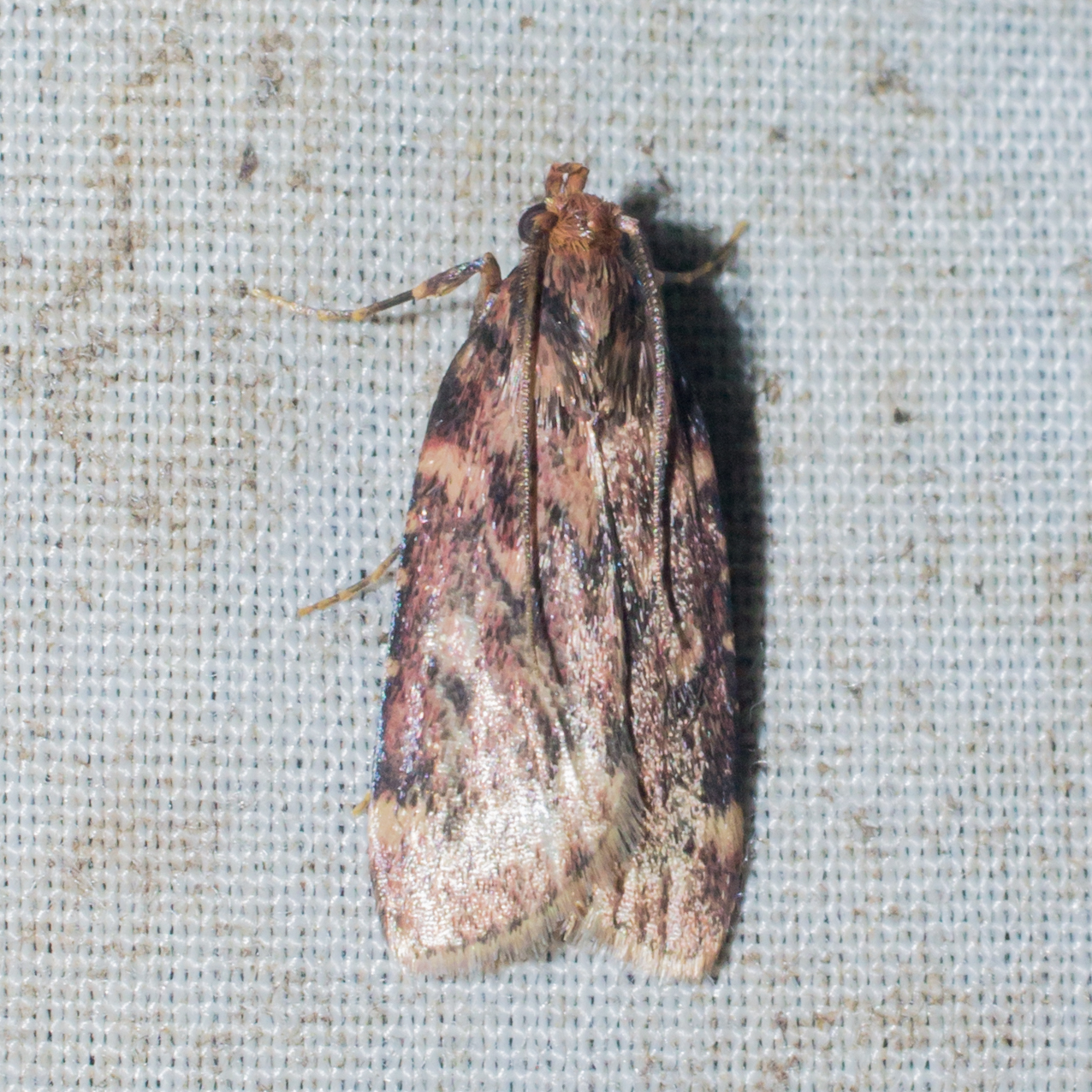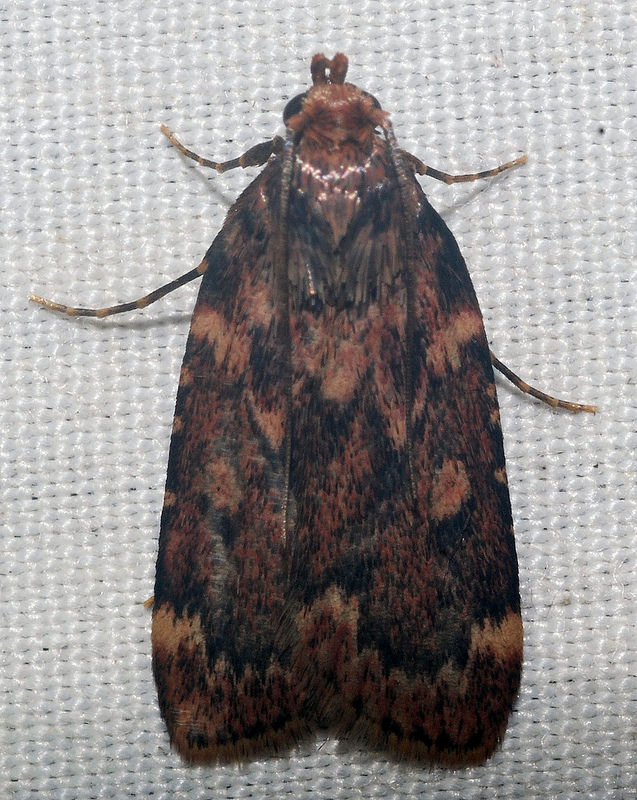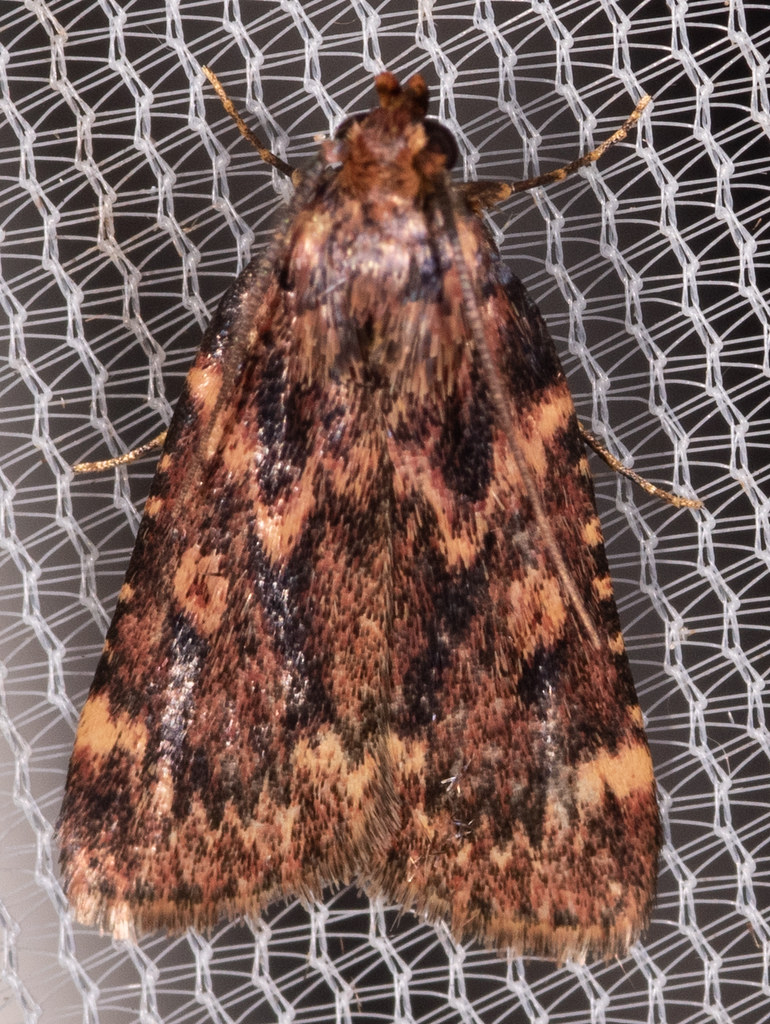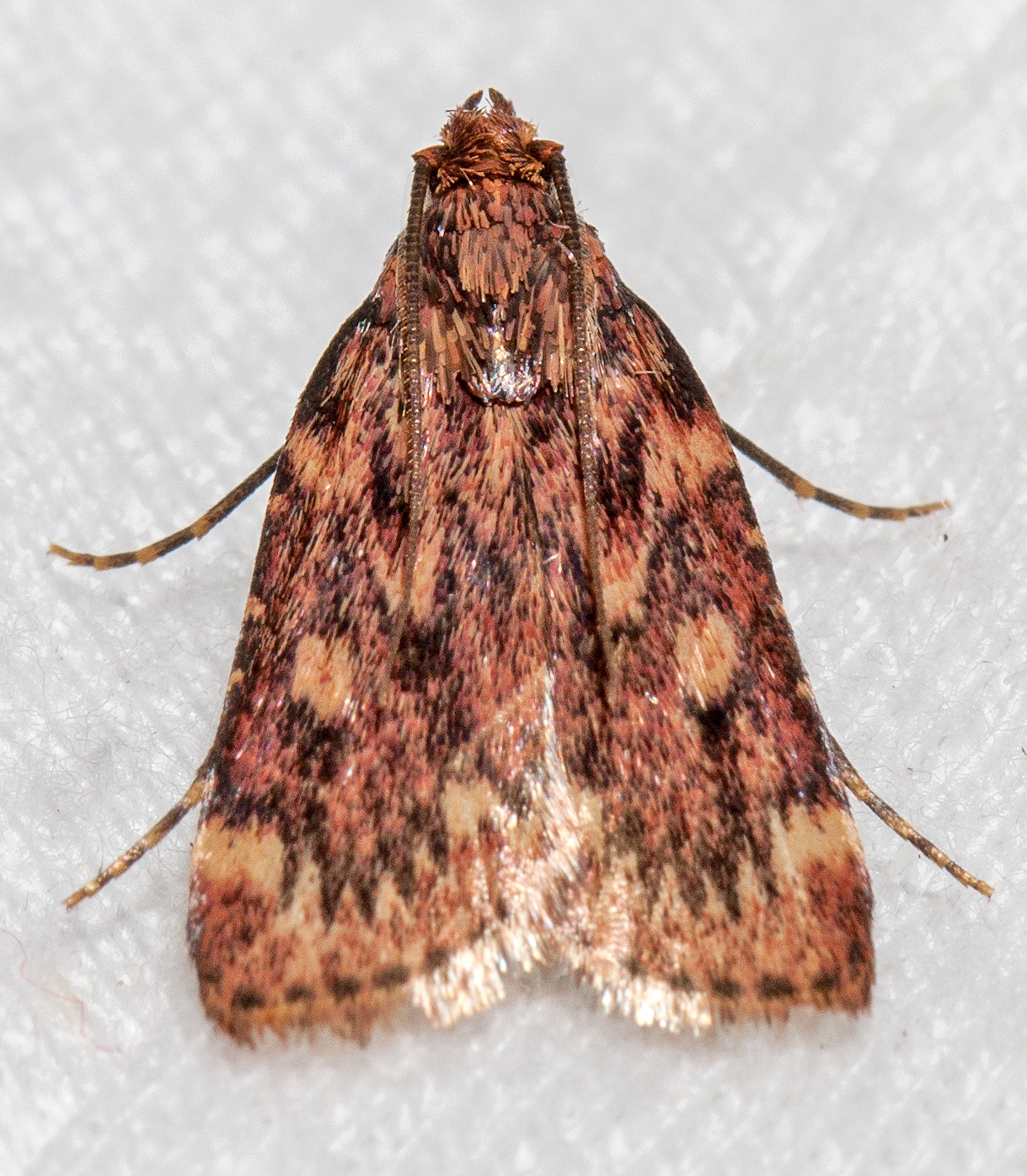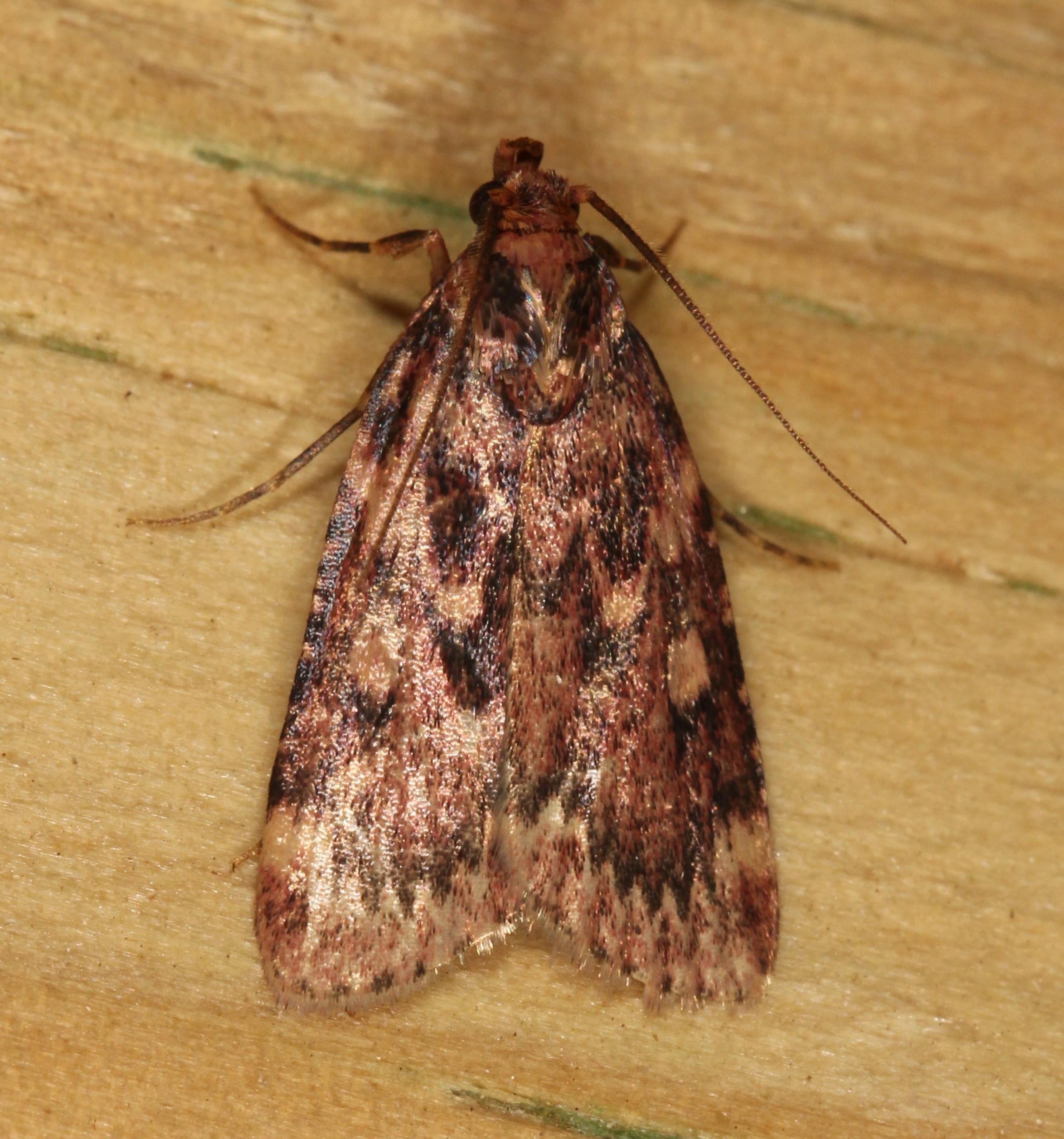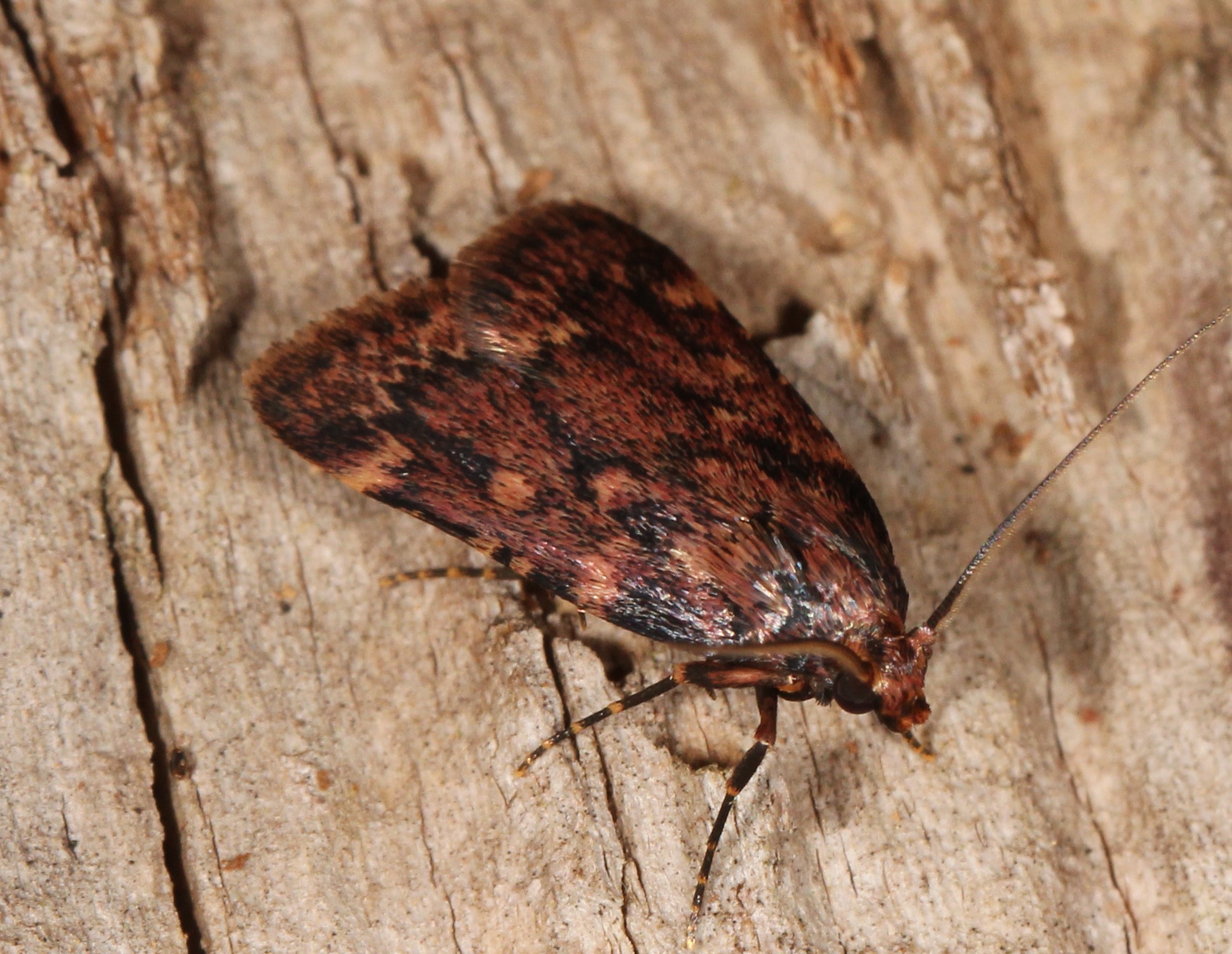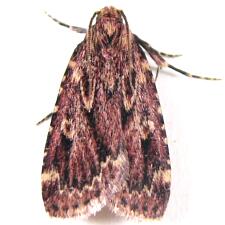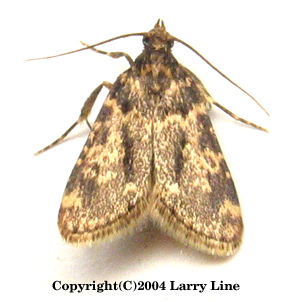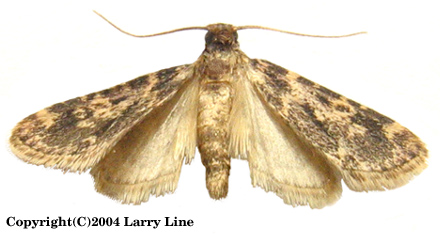Map Snapshot



















182 Records
Status
This is by far the most common species of the genus, to be found virtually everywhere in Maryland (Glaser, MicroMoths).
Seasonality Snapshot
Source: Wikipedia
This article has multiple issues. Please help improve it or discuss these issues on the talk page. (Learn how and when to remove these messages)
|
| Aglossa cuprina | |
|---|---|

| |
| Scientific classification | |
| Domain: | Eukaryota |
| Kingdom: | Animalia |
| Phylum: | Arthropoda |
| Class: | Insecta |
| Order: | Lepidoptera |
| Family: | Pyralidae |
| Genus: | Aglossa |
| Species: | A. cuprina
|
| Binomial name | |
| Aglossa cuprina (Zeller, 1872)
| |
| Synonyms | |
| |
Aglossa cuprina, the grease moth, is a snout moth, family Pyralidae, described by Philipp Christoph Zeller in 1872.[1][2][3][4] The grease moth is closely related to the genus Pyralis,[5] and as a result, is usually associated with the meal moth, Pyralis farinalis.
Aglossa cuprina ingests grease produced by the bacteria that feed on decaying matter.[6]
Taxonomy
[edit]A. cuprina was named by German entomologist Philipp Christoph Zeller in 1872.[7] The specific epithet, A. pinguinalis, its other binomial name, is derived from the Latin, pinguinalis (greasy).[8]
Description
[edit]The egg of A. cuprina is an off white rounded oval. During the larval stage, A. cuprina has a brownish head and greyish body. The A. cuprina larvae also have black mandibles and a black peritreme (part of the integument of an insect which surrounds the spiracles). They can be distinguished from A. caprealis larvae by setal differences. The pupae are reddish brown with six curved, hooked setae.
The moth has a wingspan that averages about an inch and a half (38 mm), and exhibits an overall dark, greyish-brown colour. While the forewings are brownish grey with pale yellowish markings (much like those of a tabby cat, hence the lesser-used common name), the top of the head and neck are simply pale yellow. A. cuprina is also known for its filiform (thread-like) antennae.[9]
Distribution
[edit]A. cuprina has been found in Europe, Asia, Australia, North America and South America.[10] A. cuprina is distributed throughout eastern North America and sightings have been recorded in California, Arkansas, Arizona, Connecticut, the District of Columbia, Delaware, Florida, Illinois, Massachusetts, Maryland, Missouri, North Carolina, New Hampshire, New Jersey, New York, Pennsylvania, South Carolina, Texas and Wisconsin.[11] The moth stage is generally found in early summer between the months of May and August.
They tend to inhabit areas around or in human habitation and buildings. When found in homes, they are generally found in the kitchen and more specifically in the pantry where their choice food source is stored. They are also commonly found in areas where dried grain products are stored, for example, warehouses and areas of grain elevators that remain undisturbed.
Behaviour
[edit]Aglossa cuprina has similar feeding habits to those of the grains moths. The larval stages feed primarily on dried grain based products including corn meal, whole wheat flour, graham flour, granola, and dried oats.[12] The adults feed on butter, suet and grease, and have even been found in excrement.[13] They have been known to feed on dried remains of other insects as well. The adults fly at dusk between June and July. They hide in dark corners during the day and can be found in stables, outhouses, barns, warehouses, and cellars.[14] They are also attracted to light and sugar.[15]
Forensic importance
[edit]A. cuprina is often involved in stored product entomology. Stored product entomologists often advise producers on ways to reduce the chances of insect infestation and thus remain under food defect action levels. A. cuprina is a common aspect of stored product entomology due to its caterpillars' feeding habits. Grease moth larvae infest dried grain products and as it feeds it produces a silken substance that intertwines with the surrounding product. With substantial infestations, the larvae will spread throughout the product and with them spread their silk rendering the product unsellable. Most infestations occur in products that are stored for long periods of time in storage facilities.
In addition to stored product entomology, recently evidence suggests that A. cuprina may soon play a role in forensic entomology. A. cuprina was recently found feeding on the greasy remains of a deceased individual.[16] The use of A. cuprina as an insect of significant forensic importance is still being researched.
Research
[edit]Research on the species' life cycle has yet to be completed, but it has been shown to have a similar life cycle to that of Aglossa caprealis. A. caprealis lays an average of 60-300 eggs during a single reproductive cycle. The eggs are commonly laid on overhanging supports. The time it takes for the eggs to hatch is temperature dependent and take between 2–14 days to hatch.
Once the eggs have hatched, the larval stage will last 2–41 weeks before pupating. The larval stage prefers to live in dark secluded environments, and creates flexible tubular galleries. The galleries are supported by silken fibres produced by the larvae.
Prior to pupation, the larvae leave their galleries and disperse to a suitable location. They entangle themselves with a loose, tough silken cover that they interweave with nearby material. The nearby materials provide structure to the silken covering and camouflage the moth while it undergoes metamorphosis. The duration spent in each stage of development is temperature dependent. The life cycle of A. cuprina has been recorded to range from approximately twelve months to over two years depending on weather and temperature conditions. The imago, adult insect, stage emerges in early summer.[17]
References
[edit]- ^ "The Lepidoptera of Wayne County, Ohio". Ohio Agricultural Research and Development Center. Ohio State University OARDC. 10 March 2009.
- ^ Solis & Shaffer. (1999). Contribution Towards the Study of the Pyralinae (Pyralidae): Historical Review, Morphology, and nomenclature. Journal of the Lepidopterists' Society. 53 (1), 1-10.
- ^ "Aglossa cuprina". Universal Biological Indexer and Organizer. 2009. The Marine Biological Laboratory. 18 March 2009.
- ^ Clark, Dale. "Moths of Dallas County, Texas". 8 September 2008. 18 March 2009.
- ^ Entomological Society of Washington, Smithsonian Institution Dept. of Entomology. Proceedings of the Entomological Society of Washington. Vol. 10. Washington D.C.: 1909. 25 January 2008. Google Books. pp. 97-217. 10 March 2009.
- ^ Brundage, Adrienne (March 23, 2009), Other Arthropods of Forensic Importance, vol. Texas A&M University, Texas A&M University Forensic Entomology Lecture.
{{citation}}: CS1 maint: location missing publisher (link) - ^ "Aglossa cuprina". Zipcodezoo. 17 March 2009. The BayScience Foundation, Inc. 20 March 2009.
- ^ Butler, Edward Albert. Our Household Insect: an account of the insect-pests found in dwelling-houses. New York: Longmans, Green, and Co., 1893. 29 January 2008. Harvard University Library, Cambridge, MA. Google books. 10 March 2009.
- ^ Carter, James David. Pest Lepidoptera of Europe: With Special Reference to the British Isles. Springer, 1984. Google Books. Pg. 204. 16 March 2009.
- ^ Simmons, Langley. "Additions to the Wild Fauna and Flora of the Royal Botanic Gardens, Kew: III". Bulletin of Miscellaneous Information (Royal Gardens, Kew). Vol. 1907, No. 5. pp. 156-187. JSTOR 4118357. 18 March 2009.
- ^ Solis, M. Alma (May 2008). "Pyraloidea and Their Known Hosts (Insecta: Lepidoptera) of Plummers Island, Maryland". Bulletin of the Biological Society of Washington. pages 88-106. doi:10.2988/0097-0298(2008)15[88:PATKHI2.0.CO;2]
- ^ "Grain Moths". Pests. 13 March 2009.
- ^ "The Lord’s Committee on Rabies". The British Medical Journal. 20 August 1887. PubMed Central. p 424. U.S. National Institutes of Health. 18 March 2009. doi:10.1136/bmj.2.1390.414
- ^ "Entomology". The American Naturalist. Vol. 18, No. 5. Pg. 534-542. May 1884. JSTOR 2450238. 18 March 2009.
- ^ De Prins, Willy, and Chris Steeman. "Aglossa pinguinalis". Catalogue of the Lepidoptera of Belgium. 5 Mar. 2009. Flemish Entomological Society. 18 March 2009.
- ^ Brundage, Adrienne (23 March 2009), Other Arthropods of Forensic Importance, Texas A&M University Forensic Entomology Lecture.: Texas A&M University
- ^ "1421 Large Tabby Aglossa pinguinalis". UKMoths: Your guide to the moths of great Britain and Ireland. 2009. Ian Kimber. 18 March 2009.
Further reading
[edit]- Ackermann A. “Occurrence of Aglossa pinguinalis inchworms in the intestine.” Deutsche Medizinische Wochenschrift. 95–96. Vol. 35. 1909. ISI Web of Knowledge. Medical Sciences Library, College Station, TX. 17 Mar. 2009.
- Buckler, William, Stainton, Henry Tibbats, and George T. Porritt. The Larvae of the British butterflies and moths. Vol. 9. London: Ray Society, 1901. 28 Jan. 2007. The Library of Congress, Ann Arbor, MI. Google books. Pg. 26–36. 16 Mar. 2009.
- Butler, Edward Albert. Our Household Insect: an account of the insect-pests found in dwelling-houses. New York: Longmans, Green, and Co., 1893. 29 Jan. 2008. Harvard University Library, Cambridge, MA. Google books. 10 Mar. 2009.
- Carter, James David. Pest Lepidoptera of Europe: With Special Reference to the British Isles. Springer, 1984. Google books. Pg. 204. 16 Mar. 2009.
- Entomological Society of Washington, Smithsonian Institution Dept. of Entomology. Proceedings of the Entomological Society of Washington. Vol. 10. Washington D.C.: The Entomological Society of Washington, 1909. 25 Jan. 2008. Google books. Pg. 97-217. 10 Mar. 2009.
- Fraval, Alain, and Claire Villemant. Three Successive Regulation Patterns of Gypsy Moth (Lepidoptera, Lymantriidae) Populations in the Mamora Cork Oak Forest. Le Courrier De L’Environment De L’Inra. 13 Mar. 2009.
- Humphreys, Henry Noel, and Obadiah Westwood. British moths and their transformations. Vol. 2. London: 1845. 11 Sept. 2006. Google books. Pg. 90. 17 Mar 2009.
- Pinero, FS. “Coprophagy in Lepidoptera: observational and experimental evidence in the pyralid moth Aglossa pinguinalis.” Journal of Zoology. Vol. 244. Mar. 1998. Pg. 357. ISI Web of Knowledge. Medical Science Library, College Station, TX. 19 March 2009.
- Sheppard, A.C. "Palaerctic Lepidoptera in the Province of Quebec." Ann Entomol Soc Quebec (Sep. 1974): 119–120. Agricola. EBSCO. Medical Science Library, College Station, TX. 17 Mar. 2009.
- Solis & Shaffer. (1999). Contribution Towards the Study of the Pyralinae (Pyralidae): Historical Review, Morphology, and nomenclature.[permanent dead link] Journal of the Lepidopterists' Society.. 53. (1), 1-10.
- Perez-Lopez, F.J. “The coprophagous specialization in the larvae of Aglossa pinguinalis (Linnaeus, 1758) (Lepidoptera: Pyralidae).” SHILAP Revista de Lepidopterologica [SHILAP Rev. Lepidopterol.]. 41–48. Vol. 30. 2002. Entomology Abstracts. ProQuest. Medical Sciences Library, College Station, TX. 17 Mar. 2009.
- Work, Timothy and Deborah McCullough. "Lepidopteran Communities in Two Forest Ecosystem During the First Gypsy Moth Outbreaks in Northern Michigan ." Environmental Entomology 29.5Oct 2000 884–900. 10 Mar 2009.
